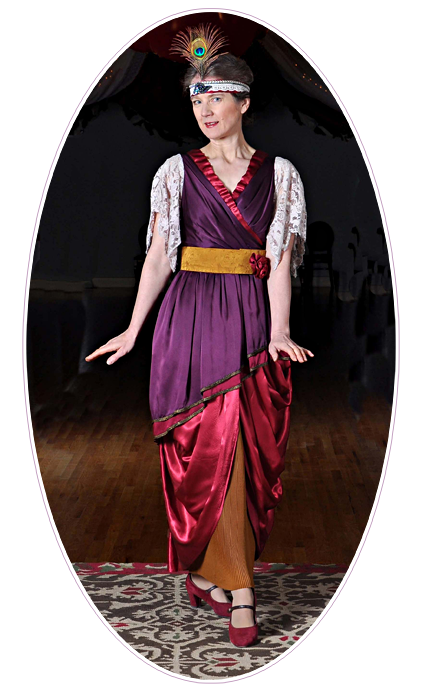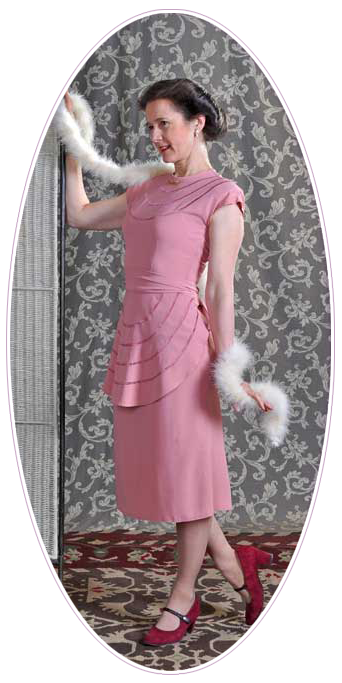Irene Castle
Dancer - Trendsetter - Animal Rights Activist
Program Description

The entrepreneurial audacity and artistic flair of Vernon and Irene Castle met the new, uniquely American, syncopated or ragged–rhythmed music (aka “Ragtime”) to fuel a dance craze explosion that swept across America. Vernon and Irene capitalized on the golden age of vaudeville, dreamed up posh dance halls, invented instructional short films, and shot an outrageous silent feature film — netting and splurging fortunes along the way. Their brief, incandescent career strewed numerous legacies in its wake: bobbed hair, challenges to the color barrier, and an unexpected altruism born of a heartless side of vaudeville.
As the 20th century dawned, Americans flocked to the cities for work. Immigrants flooded across our borders. For the first time in American history, the urban population exceeded the rural. New music with syncopated or “ragged” rhythms traveled up the Mississippi and flourished with the expanding urban population. This new “rag-time” music inspired radically new forms of dance. By 1910 the establishment railed against the unsavory honky-tonk origins of the Turkey Trot, the Grizzly Bear, and the scandalous Bunny Hug (banned in many ballrooms).
Enter Vernon and Irene Castle, who made ragtime dancing not just socially acceptable but downright fashionable with their elegant grace. They took a dance form frowned upon by respectable society, and transformed it into a most stylish hobby for rich and poor alike, for old and young. The Castles enchanted the nation: Here was a married couple who actually showed affection to one another in public! In these years before even the silent film industry had taken hold, the Castles laid the groundwork for public fascination with private romance.
In addition to changing the way Americans looked at and moved to music, the Castles influenced the way the world looked at America. Since Colonial times, culture and fashion had propagated west from Paris and London to America. Ragtime music, and ragtime dance, reversed this long-standing practice. In 1912 the Castles became the darlings of the Parisians and all the upper crust of Europe who spent time in the City of Lights - a dozen years before Josephine Baker would wow audiences there. Suddenly the continent of Europe wanted to emulate the United States. European fascination with American music and dance continues to this day. Meanwhile, back at home, the Castles broke molds in fashion, in the color barrier, and in humane treatment of animals.

Many associate “bobbed” hair with the 1920’s. Few realize Irene Castle bobbed her hair in 1915. The first week after she appeared with shorn locks, two hundred and fifty women lined up for “Castle bobs”; the next week twenty-five hundred. Not wanting her short hair to fly around when dancing, Irene sewed a jeweled band to slip over her head. In no time “Castle bands” were all the rage.
One new dance, the “Half-and-half” in 5/4 time, required new music, created by their orchestra leader, James Europe. Irene wrote, “It was we who made colored orchestras the vogue of Fifth Avenue. We booked Jim Europe’s orchestra, the most famous of the colored bands. Jim Europe was a skilled musician and one of the first to take jazz out of the saloons and make it respectable.”
From their early Vaudeville days, Vernon and Irene recoiled at the abusive treatment of stage animals. This led to Irene’s most lasting legacy: working for the humane treatment of all animals owned or controlled by humans. While less glamorous than starring on Broadway, her animal shelter Orphans of the Storm continues to assist thousands of animals today, more than eight decades after its founding.
Irene looks back from the 1940s (several husbands and decades later) to reflect on her dance escapades with Vernon, his time as a pilot in World War I, and her second career as an animal rights activist.
The one-hour program consists of a 40-45 minute monologue in-character, followed first by a question and answer period with "Irene Castle" and then by a question and answer period with the scholar/presenter, Susan Marie Frontczak.